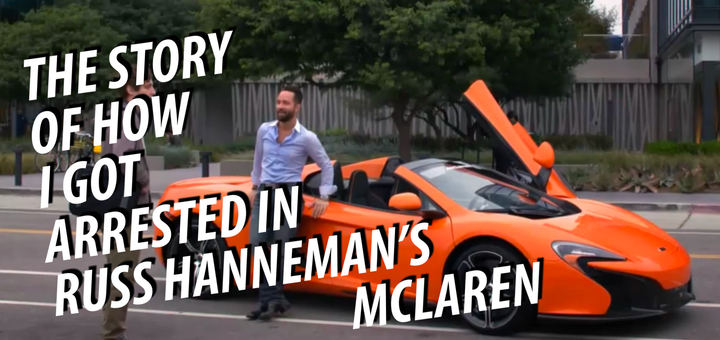
How Edgar Zabunyan’s abuse of power and reckless negligence almost cost me my career.
I’ve never been arrested in my life before this. I have no criminal record. My driving record is spotless (save a turn signal ticket). But less than 24 hours after taking possession of Russ Hanneman’s bright orange McLaren 650S Spider, I’ve got the boys in blue arresting me, towing the car, and going on about how they almost called in an “airship” to take me down.
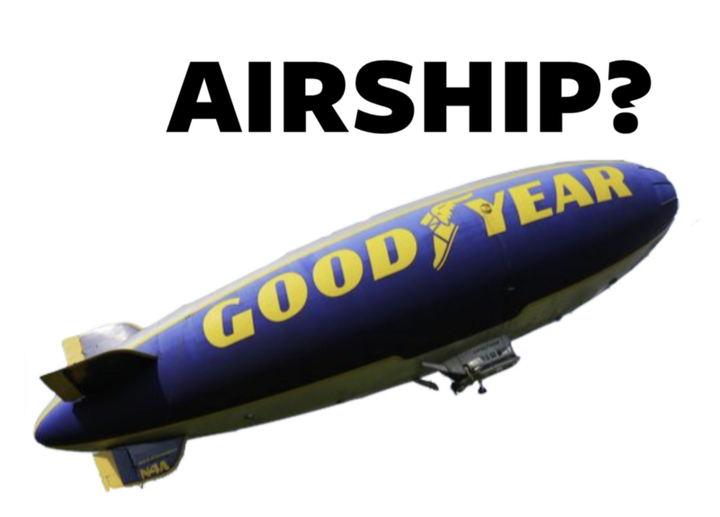
Warning: this tale is stranger than fiction. It’s a cautionary tale for drivers everywhere (especially ones with flashy sports cars). But it’s about more than just one automotive journalist’s unwarranted Friday night run-in with the law. It’s about how unbeknownst to most, police have regressed to a wild west way of doing things. Supported by judges handing down convictions based on a highly fallible archaic system. I’m talking about visual estimation of speed, which is the authority to cite citizens — and arrest them — based on what speed an officer thinks they were traveling. No measuring equipment whatsoever; the primeval equivalent of convicting someone guilty based on “gut.” There’s a very good reason police departments have used advanced technology to record speed for almost seven decades — the human brain is fallible at calculating visually observed velocity. Yet, at least in California, they seem to have regressed to the ancient system of using no technology at all.
It started on a gorgeous Friday night in the City of Angels. I was testing the McLaren 650S Spider through the Angeles National Forest for a major magazine. My co-pilot and I decided to see a movie at The Americana at Brand, an outdoor shopping center in Glendale. It was around 7 p.m. when we arrived at the entrance to The Americana. As we waited for pedestrians to cross before making the right turn towards the parking garage, my co-pilot and I joked about the funny hat on the security guard as he walked across the road.
Turns out, the funny hat was the least of our concerns.
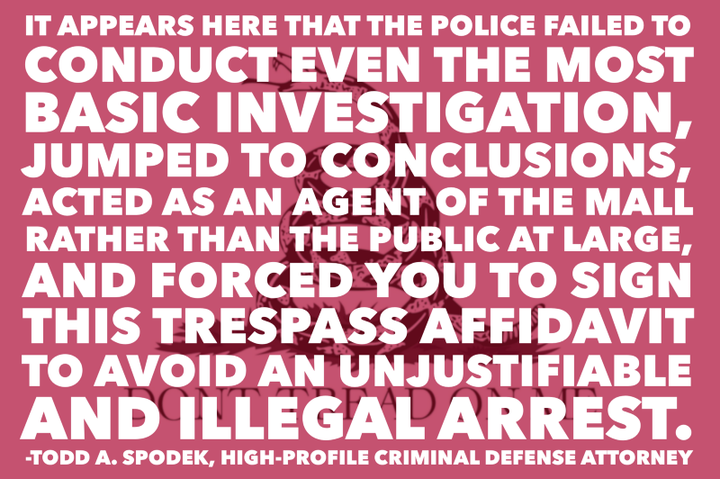
What happens next is the most ridiculous police encounter I’ve ever experienced.
I’ve been an automotive journalist for several years and have tested almost every car under the sun over tens of thousands of miles. The most serious ticket I’ve ever received prior to this: failure to use my turn signal while changing lanes on a trafficless Idaho highway.
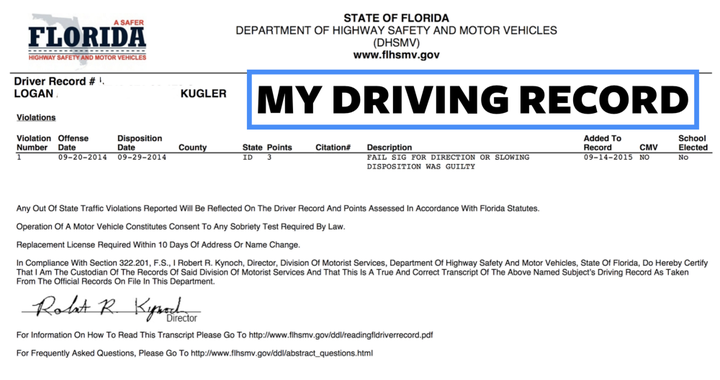
But today, I was destined to be a Menace to Society — thanks to Russ Hanneman’s orange McLaren.
After the pedestrians (and the security guard in the funny hat) had crossed, I turned onto Americana Way and blipped the throttle on the McLaren. I slowed for the turn into the parking garage, was pulling up to pull my parking stub, and that’s when I saw a police cruiser fly around the corner at lightning speed, lights ablaze.
Not having anywhere to pull over, locked in my lane by two curbs on either side as I approached the parking gate, I stopped just before the gate and turned off the ignition.
“What took you so long to stop!?” the officer shouted.
Uh oh. I was pretty sure it wasn’t a joke, though it should have been: I had traveled about a hundred feet into the garage and stopped in about as much time as it takes to sneeze.
It was the first in a series of jokes-that-weren’t-really-jokes that night.
“What the heck are you doing out here?” the officer snapped.
“I’m not sure what you mean,” I replied, legitimately confused. Instead of explanation, I got: “License and registration!”
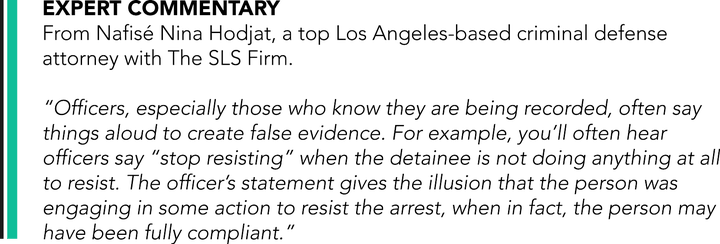
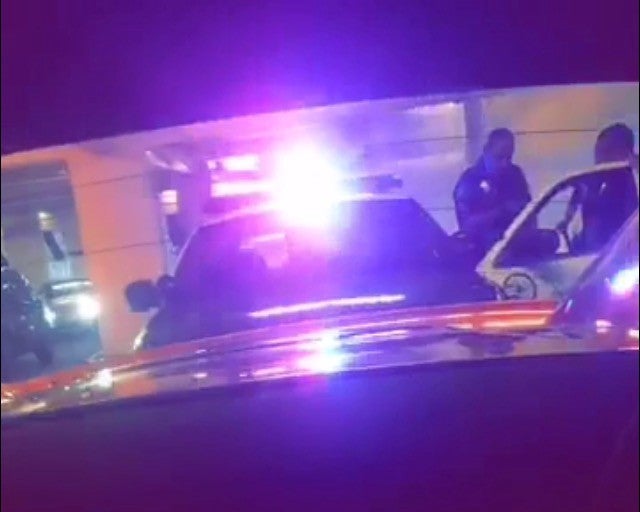
The police behind me in the parking garage just before the ticket gate.
Things quickly deteriorated in a cascade of almost comedic proportion. While the officer ran my license and registration, the security guards for The Americana at the Brand approached the car.
“We’ve seen you here a ton of times over the last couple of months causing trouble in this orange McLaren,” they said. Well, that’s impossible because I’d picked up the car 24 hours earlier. As much as I’d love to own an orange McLaren, this crazy machine was mine only temporarily. Oh, and the last time I was at The Americana at Brand was more than three years ago.
It seemed to be a case of mistaken identity, but the security guards weren’t having it. They were convinced one orange McLaren must be every orange McLaren (despite this being Los Angeles, one of McLaren’s largest markets).
They promptly handed me a “Criminal Trespass” notice that banned me from the property for a year. I was told to sign or the kind police officers would take me to jail.

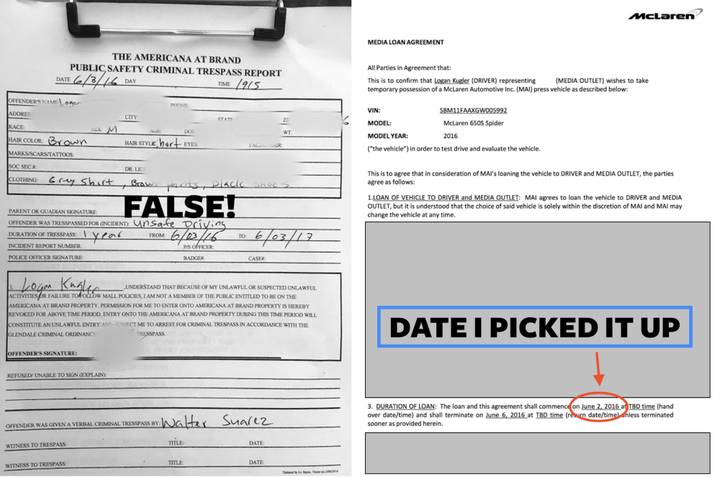
Shows the date of the report was one day after I picked up the car.
By now, three more police officers had arrived. They gave me a police escort as I backed the McLaren out of the garage and back out onto the main street to resolve the traffic jam that was cropping up behind us.

The officer who’d stopped me told me to step out of the vehicle. Which is when I was acquainted with Officer Edgar Zabunyan. Zabunyan told me to put my hands behind my head. He frisked me and my passenger. I didn’t even know what the offense was.
Officer Zabunyan informed me, “You’re getting a ticket for Reckless Driving.”
Not even in a parallel universe (which I increasingly think I inhabit) was pulling into a parking garage considered reckless. I’m an automotive journalist: I know Reckless Driving is one inch short of vehicular manslaughter in seriousness.
“You were going 40 or 45 mph by my visual estimation in a 5 mph zone!” he declared. “And I’m certified in visual estimation.”
‘He’s certified in visual estimation?’ I thought to myself. Sounded odd, but this wasn’t the time or place to question his macho-ness. Officer Zabunyan was clearly a loose cannon.

The ticket.
It all became clear when Officer Zabunyan read me my Miranda rights. He had some massive chip on his shoulder.
He said he knows my kind. He said had the ticket gate to the parking garage not been there, I would have started a police chase and he would have had to “call in an airship and got the whole department down here.”
Here’s an entertaining video which is a great example of how officers should behave; calm, collected and maintaining order, not by raising their tone of voice and escalating, but by being calm and friendly. These officers might win the award for the most laid back cops, ever.
Here I was thinking I would see a movie with a friend. Instead, I had an officer of the law painting a picture of a scene right out of a Michael Bay flick. It would have been comical if my personal and professional reputations weren’t at serious risk of being trashed thanks to these invalid charges.
Officer Zabunyan told me he wasn’t going to bother taking me to jail and was merely arresting me on the street, then immediately releasing me. I breathed a sigh of relief.
But then Zabunyan said he was taking the McLaren.
He was going to tow it and impound it for 30 days. I could see the headlines now: ‘rookie tow-truck driver busts up $325,000 McLaren.’ As the tow truck pulled up, I got desperate to prevent the ramifications of this from bleeding over to McLaren, too. I profoundly pleaded my concerns to Officer Zabunyan’s partner. After a few minutes of discussion, the police informed me they weren’t going to tow the car.
However, they said that if they received any reports of an orange McLaren involved in an accident or anything else, whether it was my fault or not, they were going to take me to jail and charge me with at least half of the Glendale Municipal Code. Whether or not it was my fault.
Guilty until proven innocent, I guess?
And remember the security guard with the funny hat? The police told me he testified to them that I nearly ran him over when I turned onto Americana Way. In reality, he was over 20 feet away on the opposite side of the road (I remember precisely where he was standing when I made the turn because we were joking about his hat).
At the time of the ticket, I knew I was going to fight it and I knew I was going to win because of how fabricated and unjust the entire situation was. But I also knew it was going to cost me a great deal of time.
Officer Zabunyan and his cronies had built a nice little house of cards out of lies, but it quickly collapsed under expert scrutiny.
Multiple expert sources confirm that Officer Zabunyan’s actions, as well as those of the police department, were unwarranted, based on reckless negligence, elaborate embellishment, and a complete abuse of power.
In preparing my defense, I submitted a public records request with the City of Glendale, I spoke with a City of Glendale traffic engineer, talked with McLaren about the 650S’ actual acceleration capabilities, and spoke with The Americana at Brand’s security office, parking office, management office, and executive office.
Here’s what I learned:

The ticket states I was traveling at 40 mph. McLaren says it’s physically impossible. McLaren’s PR director and I exchanged a few emails about this and McLaren engineers were consulted, but McLaren’s legal department wouldn’t permit an official statement.
The gist of the conversation was the McLaren 650S is not capable of reaching anywhere near the speed that Officer Zabunyan claimed it did in the distance provided.
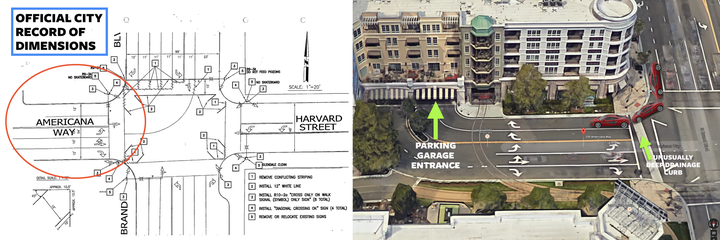
Where this all happened.
The street is precisely 78.725 ft. long with a 90-degree upslope corner at the end of it that ejects you into The Americana at Brand’s parking garage. The McLaren 650S is 14.8 feet long. Acceleration can’t begin until the car is fully straight on the road because there’s an unusually deep drainage curb in the crosswalk of that intersection, which had to be fully cleared at crawling speed, preventing the ability to accelerate mid-corner.
That leaves a 63.93 ft. long road to accelerate to 40 mph and brake for a 90-degree corner. That’s roughly the length of a school bus and a Honda Accord welded together. I don’t think even a Ducati Panigale R (one of the fastest superbikes in the world) could hit 40 and slow for a 90-degree corner in that distance.
A 650S, at best, requires 131 feet to reach 60 mph. And “at best” means: perfect tarmac (i.e. groomed racetrack surface) and Launch Control being used, neither of which apply here. Taking two-thirds of that for 0 to 40 mph would be 87 feet. But as car enthusiasts know, it isn’t a linear curve because the car builds up speed as it gains momentum, like the upswing of a bell curve. So it will take longer to reach 20 mph than it will to accelerate from 40 to 60 mph. So even with a groomed racetrack and Launch Control being used, it would be the absolute limit of the car’s capability to reach the claimed 40 mph in 87 feet. And the officer claimed I reached 40 mph and slowed for the 90-degree corner in just 63.93 feet. Even if there was no corner, it’s impossible. And I slowed gently for the corner; there was no threshold braking or tire squeal.
What Officer Zabunyan claimed he witnessed is simply impossible. Here’s more evidence:
Cars are significantly slower to accelerate using a rolling start than they are from a dead stop. I was rolling past the crosswalk at between 2 and 4 mph (in order to clear the drainage curb) before accelerating. For example, a car which normally accelerates from 0 to 60 mph in 4.5 seconds will take 5.5 seconds to go from 5 to 60 mph (BMW M235i). 60 mph in 131 feet is based on accelerating from 0 mph. Since it was a rolling start, it would require even greater distance than 87 feet to reach 40 mph. And again, even 87 feet would require perfect tarmac and engaging Launch Control (which requires a start from 0 mph and holding down full throttle for several seconds to build boost before letting off the brake — an impossibility because the Launch Control function was inoperable on the car I had).
It is simply impossible for the vehicle to have been traveling at anywhere near the rate of speed Officer Zabunyan declared on the ticket.
Officer Zabunyan heard a loud exhaust, saw the car settle from going over the drainage curb, saw bright orange, and his brain extrapolated a speed vastly greater than reality.
Bizarrely, Zabunyan added to his police report that he went to McLaren’s website and learned that the car does 0 to 60 mph in 3 seconds, thus somehow conclusively substantiating his 40 mph claim. That logic is lost on me.
This is the tire screeching, tire smoking calamity that is required to reach even those best case scenario numbers by using Launch Control, which it was not here.

In an optimistic world, I touched 20 mph. Which is why I was genuinely confused when I was pulled over. If I reached 25 mph for even less than a tenth of a second, I’d eat my shoe. That’s how certain I am about how slow I was going. Sadly, the car doesn’t log any data (I asked McLaren if they could pull a time and/or geo-stamped speed from the car’s computer).

The ticket states the speed limit was 5 mph. In actuality, it was 25 mph.
There’s no posted speed limit until you enter the garage. The Americana at Brand provided me with an official statement confirming that Americana Way, where the offense took place, is a local city street. The default speed limit in a business district in the City of Glendale where there is no posted speed limit is 25 mph.
The ticket states the violation occurred at 889 Americana Way, the west entrance. It happened at 200 Americana Way, which is the east entrance. Officer Edgar Zabunyan not only didn’t know the speed limit, he didn’t know where he was.
The ticket also states traffic was heavy. There was zero vehicular traffic on the road in either of the two lanes on my side of the road because I was the last car to stop to wait for pedestrian traffic.
This is where I would link to indisputable video footage from the police officer’s dash cam, but the Glendale Police Department refused to release any recordings pertaining to this case.
While writing the ticket, Officer Zabunyan told me that had I lost control while accelerating, I would have taken out every single pedestrian and car in the vicinity, and that I would have killed dozens of people. An exaggeration preposterously implausible. The road was clear. There were zero cars. The car at no time lost traction and I was at all times in complete control. Just more fact fabrication.
Towards the end of the encounter, a few minutes after I was told Officer Zabunyan was going to tow the McLaren and before he decided not to, I asked his partner if I had the right to request a supervisor. He said that I did, but doing so would further agitate Officer Zabunyan. He insinuated that while I had the right to request a supervisor, if I exercised that right, Officer Zabunyan likely would have taken my passenger and me to jail out of spite. Officer Zabunyan’s own partner, who was actually very professional, almost seemed afraid of him.
One of the first things Officer Zabunyan said to me when he pulled me over was that I’m lucky he’s the one who pulled me over because he’s one of the nicest cops in Glendale. Over the next 90 minutes, he proceeded to repeat that he’s one of the nicest officers in Glendale at least four times. Glendale California Police Chief Robert Castro, I hope you’re listening because if Officer Zabunyan is one of the nicest cops in Glendale, you have a friendliness problem in your department.
“His repeating over and over “I’m a nice person” is likely reflective of some underlying or even “unconscious” discomfort about what he is doing,” says Dr. Ramani Durvasula, Ph.D., licensed clinical psychologist and Professor of Psychology at CSULA. “This officer’s behavior indicates a psychological term known as “gaslighting,” says Dr. Lauren Costine, Ph.D., clinical psychologist and Chief Clinical Officer of BLVD Treatment Centers. “Perpetrators use gaslighting to manipulate their target into doubting their own perceptions and experiences of reality. Sociopaths and narcissists (both of which are serious mental health disorders) use gaslighting to control others and their circumstances. Often, these individuals are charming and deny any wrongdoing, or state the opposite of what is happening to disarm and confuse the person actually experiencing harm.”

The car I was driving.
Todd A. Spodek, a high-profile criminal defense attorney with Spodek Law Group, who reviewed these events in-depth said: “It appears here that the Police failed to conduct even the most basic investigation, jumped to conclusions, acted as an agent of the mall rather than the public at large, and forced you to sign this trespass affidavit to avoid an unjustifiable and illegal arrest.”
Apparently, the District Attorney agreed. On September 6th, the day of my arraignment, we were ready to go to court when the DA officially rejected prosecution of my case. My attorney said that’s such a rare action that some extraordinary circumstances must have preceded it. Either Officer Edgar Zabunyan’s tickets have a negative history with the DA, they saw some of the holes in their case, or both.

Notice from the District Attorney that they decided not to take my case to court.
To some extent, I’m disappointed.
Why?
Because I wanted to invite all McLaren owners in Southern California to the trial. This was going to be for McLaren drivers everywhere. Then again, I’m happy that it’s done and over with.
Or at least, it probably is.
See, a Rejection Notice means the DA isn’t going to file charges… for now. But they have up to a year to do so. Which means when this story publishes, they might suddenly develop a vendetta against me. However, I felt it was important to get this story of what happened out there.
I also hope this article can serve as record to Officer Edgar Zabunyan’s abuse of power and reckless negligence and help prevent a similar fate befalling other law-abiding citizens.

The Gadsden flag with the phrase “Don’t Tread on Me” combined with snake ready to strike is a warning. It dates back to 1775 and warns not to step on or take advantage of Americans or they will strike.
There’s a lot of threads in this story. Perhaps most that Officer Zabunyan has some deficiencies in performing his duties as an officer of the law. But there’s an underlying theme: If it weren’t for a police officer’s ability to arrest someone based on visual estimation of speed, this unwarranted encounter never even would have happened.
Why are police officers allowed to arrest someone based on a purely visual estimation of speed, with no equipment involved whatsoever (what’s even the point of radar?), and that their visual estimation of speed can, and often does, lead to a conviction?
If someone challenges a speeding ticket in court and it’s discovered that the radar equipment used for recording the speed missed its last certification test, the ticket is rendered invalid and dismissed. But it’s impossible for the completely unscientific visual estimation method to be challenged.
The implications of this are huge. Police officers are trained in estimating speed, yes. But can they identify someone’s speed down to 1 mph with 100% accuracy every time? No way. And that’s precisely the reason police departments starting buying and using radar devices in 1948. Radar and laser speed-measuring equipment is advanced, expensive technology that is required to be re-certified on a regular basis.
If someone is traveling 40 mph in a 20 mph zone, you can be quite confident they’re speeding. But, by how much? If a police officer is off by only 1 mph in his visual estimation, it can cost the citizen thousands of dollars in increased insurance costs by pushing his ticket into the next bracket.
It’s almost inconceivable to believe that police officers can write “VISUAL” under the Radar/Laser section of a ticket (which normally indicates the equipment used) and judges sanction and pass down a conviction for it. My attorney told me that for any speeding ticket issued in Beverly Hills that is challenged, for example, it’s heard at the Santa Monica courthouse and the judge there won’t even seriously entertain a defense for a visual estimation speeding ticket. You’re instantly guilty, based on a highly illusory measuring system.
The human brain is incapable of accurately judging the speed of a moving object with perfect accuracy every time. Never mind the fact that an officer could increase the speed he visually estimated should the offender give him any lip during the pullover, with no way to disprove the officer is lying. Police officers are emotional beings just like the rest of us. As much as I respect law enforcement, we know they can lie. In fact, during my ride-along with a police officer about two years ago, the officer told me point-blank that over half of their job is just lying to the public. I was stunned he was so upfront about it.
Allowing visual estimation of speed to be permitted as admissible and incriminating evidence is a complete liability to the liberty of people and an insult to any just judicial system. Visual estimation of speed needs to be eliminated as admissible evidence. I beat mine using science, my connections as a member of the press, and countless hours. I’ll bet 99% of the accused don’t have those kinds of resources.
Oh, and as for the movie: we decided to take our movie-watching patronage to the AMC 16 in Burbank. No funny hats there.
Special thanks to Zach, Ajay, Mike, Jelena, and Todd who volunteered their time to review drafts of this article and provide feedback. I highly recommend Nafisé Nina Hodjat of The SLS Firm if you ever get arrested in California.
This article originally published here on Medium.
